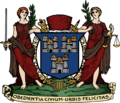History

Joseph Rathborne came from Chester to Dublin and later established a candle manufacturing business in Dublin's Winetavern Street and sites surrounding Christ Church Cathedral. For nearly 150 years Rathbornes produced their candles in this district before locating on the north side of the city near St. Mary's Abbey. [1]
In 1616 the Candlelight Law decreed that every fifth home should display a light for passers-by. Later in the seventeenth century, Rathbornes Candles was contracted to supply street lighting in Dublin. In addition, the company secured lucrative contracts supplying the lighthouses around the Irish coast. In 1650 the business was located in Cabragh Lane (later renamed Prussia Street). [2]
In 1711 Joseph Rathborne signed a lease on a parcel of ground fronting Great Britain Street (modern day Parnell Street) for a term of 90 years from 'John Brock of Dublin, Joyner'. The plot measured 20ft wide x 70ft long and warranted an annual rent of £3. 7s. 6d. [3]
In 1744 William Rathborne decided to start a business outside the city. He leased a part of the lands of the townland of Dunsink from the Rt. Hon. William Connolly and erected a small workshop. In 1763 he renewed the lease of Dunsink and around this time he built a house on part of the land in Scribblestown. [1] Since then, the Rathborne family has a long association with various areas in Dublin 15 including Dunsinea, Ashtown and Scribblestown, although other historical locations for the business in Dublin are documented. [4] Near to Scribblestown there is now a housing development named "Rathborne". [5]
William Rathborne died in 1779 and the business passed on to his son William. He in turn passed on the firm to his son Henry, who built a fine house in 1811, called Dunsinea House. The house is now part of the headquarters of Teagasc.

In 2002, the company moved from the East Wall Road, Dublin, its premises since 1925, to its current location in Rosemount Business Park, Blanchardstown, Dublin 15.
